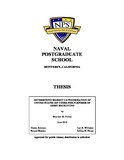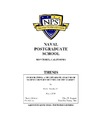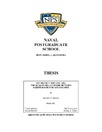Determining market categorization of United States ZIP codes for purposes of Army recruiting
| dc.contributor.advisor | Whitaker, Lyn R. | |
| dc.contributor.author | Fulton, Brandon M. | |
| dc.date | 16-Jun | |
| dc.date.accessioned | 2016-08-02T19:34:58Z | |
| dc.date.available | 2016-08-02T19:34:58Z | |
| dc.date.issued | 2016-06 | |
| dc.identifier.uri | https://hdl.handle.net/10945/49463 | |
| dc.description.abstract | The Army relies on Zone Improvement Plan (ZIP) codes to assign recruiters and to track recruit production. ZIP codes have different densities of potential recruits; the Army uses commercial market segmentation data to analyze markets and past accessions to assign recruiters and quotas to maximize production. We use 347 variables from publicly available United States government agencies for each of 34,007 ZIP codes to cluster ZIP codes into similar groups. We use between 2 and 18 clusters for each of five categories of data, using three dissimilarity calculation methods, and three clustering algorithms. Using national recruiting leads as a proxy for market potential, we find the best cluster assignment by fitting Poisson regressions predicting leads from ZIP code cluster membership. Economic cluster assignments predict leads with a pseudo R-squared value of 0.69, reducing the need for United States Army Recruiting Command to rely on proprietary data with 66 market segments per ZIP code for market analysis and predicting recruiting potential. These 18 clusters provide an easier tool for recruiting commanders. Additionally, these clusters offer a new method of identifying potentially high-production ZIP codes without using previous accessions and the highly correlated number of recruiters assigned as predictor variables. | en_US |
| dc.description.uri | http://archive.org/details/determiningmarke1094549463 | |
| dc.publisher | Monterey, California: Naval Postgraduate School | en_US |
| dc.rights | This publication is a work of the U.S. Government as defined in Title 17, United States Code, Section 101. Copyright protection is not available for this work in the United States. | en_US |
| dc.title | Determining market categorization of United States ZIP codes for purposes of Army recruiting | en_US |
| dc.type | Thesis | en_US |
| dc.contributor.secondreader | House, Jeffrey B. | |
| dc.contributor.department | Operations Research (OR) | |
| dc.subject.author | recruiting | en_US |
| dc.subject.author | tree clusters | en_US |
| dc.subject.author | unsupervised | en_US |
| dc.description.recognition | Outstanding Thesis | en_US |
| dc.description.service | Major, United States Army | en_US |
| etd.thesisdegree.name | Master of Science in Operations Research | en_US |
| etd.thesisdegree.level | Masters | en_US |
| etd.thesisdegree.discipline | Operations Research | en_US |
| etd.thesisdegree.grantor | Naval Postgraduate School | en_US |
| dc.description.distributionstatement | Approved for public release; distribution is unlimited. |
Files in this item
This item appears in the following Collection(s)
-
1. Thesis and Dissertation Collection, all items
Publicly releasable NPS Theses, Dissertations, MBA Professional Reports, Joint Applied Projects, Systems Engineering Project Reports and other NPS degree-earning written works. -
2. NPS Outstanding Theses and Dissertations





